Fortified wine is a unique and fascinating drink created by adding a distilled spirit like brandy to wine. This process increases the wine’s alcohol content and deepens its flavors, offering various styles from dry and crisp to rich and sweet.
The tradition dates back centuries. Initially developed to help preserve wine for long journeys, fortified wine has evolved into a beloved category enjoyed worldwide.
Today, fortified wines like Port, Sherry, and Madeira are popular because of their versatility. Whether savored alone, paired with food, or used in cooking, they offer a bold and complex flavor profile that makes them timeless favorites for wine lovers.
What is a Fortified Wine?
Fortified wine is a unique category of wine that has been “fortified” with additional distilled spirits, often brandy, to increase its alcohol content.
Unlike regular wines, which generally have an alcohol content between 9% and 14% ABV, the alcohol content of fortified wines is between 15% and 22% ABV. This addition not only boosts the wine’s strength but also helps preserve it, allowing it to age longer.
Fortified wines come in various styles, including popular varieties like Port, Sherry, and Vermouth. Each is known for its different flavors and rich history.
Consumer interest in unique, premium alcoholic beverages has contributed to the growth of the fortified wine market, and consumption is steadily increasing globally.
According to recent market trends, fortified wine is gaining significant traction in countries outside of Europe, including the United States, where it’s being integrated into cocktails and gourmet food pairings.
The fortified wine market is expected to grow at a rate of 3.8% annually from 2024 to 2032, driven by the growing demand for creative flavors and sophisticated drinking experiences.
How Fortified Wine is Made?
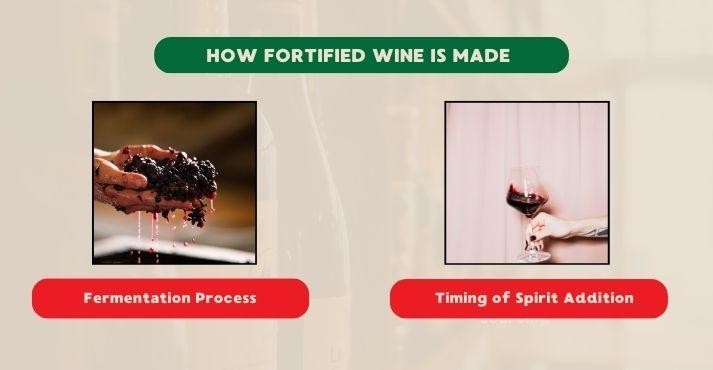
Fortified wine is a refined beverage that adds distilled spirits like brandy to a base wine. This process increases the alcohol content and preserves the wine, allowing it to age gracefully.
The result is a wine with a rich depth of flavor, making it a favorite among wine enthusiasts worldwide. Whether it’s a sweet, rich port or a dry, complex sherry, fortified wines stand apart from regular wines due to this additional step in the winemaking process.
Fermentation Process
The winemaking process for fortified wines starts with the same steps as regular winemaking, with the grapes harvested, pressed, and fermented. During fermentation, yeast consumes the sugar in the grape juice, producing alcohol.
For fortified wine, fermentation is stopped before all the sugar is converted. This creates a sweeter base wine, and distilled spirits are added to preserve the sugars.
The timing of this fortification process can drastically affect the flavor, resulting in wines with an alcohol content of 15% to 22%, ranging from rich and sweet to dry and complex.
Timing of Spirit Addition
The timing of when the distilled spirit is added determines the final taste profile of the wine. When the spirit is added during fermentation, it stops the yeast from converting all the sugars, resulting in a wine with a higher sweetness and a fuller flavor.
This is commonly seen in dessert wines like Port. If the spirit is added after fermentation, the wine retains a drier taste with a more complex, nutty flavor, such as in some Sherries and Vermouths. The skillful balance of these techniques gives each fortified wine its signature characteristics.
7 Types of Fortified Wines
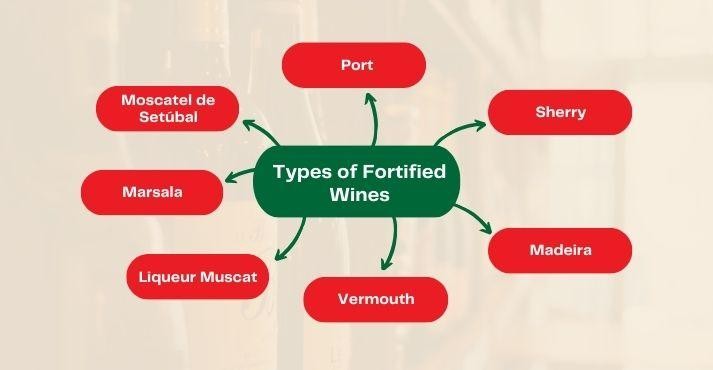
Fortified wine is rich in history, and various styles offer different characteristics. These wines, typically higher in alcohol content, are enjoyed both on their own and in cocktails.
From the rich, fruit-forward sweetness of Port to the herbal complexity of Vermouth, these wines have a prominent place in the world of wine and cocktails.
Here’s a breakdown of seven popular fortified wine types, each with its own origin, style, and ideal pairings:
1. Port
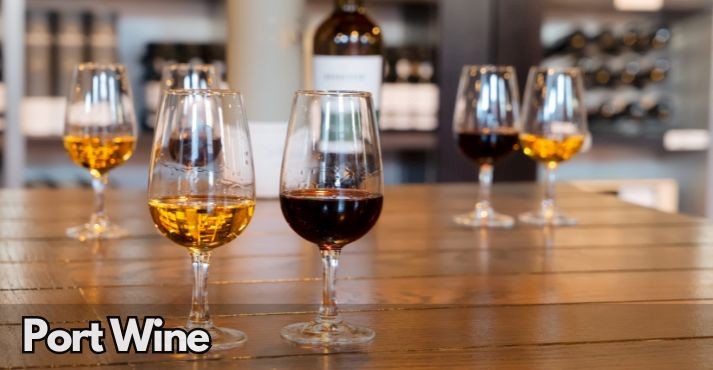
Port is a celebrated fortified wine from Portugal’s Douro Valley. Its rich, bold flavors have made it a favorite worldwide. With its distinctive taste, Port is perfect for enjoying after a meal or celebrating a special occasion.
Origins
Port wine originates from the Douro Valley in northern Portugal, a region with a long winemaking tradition.
In the 17th century, English merchants who needed to preserve wine for long sea voyages introduced the technique of fortifying wine with brandy. Over time, this technique evolved into the distinctive Port style we know today.
Production Process & Unique Characteristics
Port is produced by adding brandy to wine. This stops the fermentation process before all the sugar is turned into alcohol, leaving the wine sweeter and higher in alcohol content.
Depending on the style, it’s aged in oak barrels or bottles, allowing different characteristics to develop, from fresh fruitiness to complex, nutty flavors.
Varieties or Types
- Ruby Port: Fresh and vibrant with berry flavors, it’s the youngest form of Port.
- Tawny Port: Aged longer in oak, Tawny has a smooth, nutty character with hints of caramel and dried fruit.
- Vintage Port: Made from the best grapes of a single harvest, it’s the most complex and can be aged for decades, developing rich, dark fruit and spice notes.
Taste Profile
Port offers many flavors, from Ruby Port’s fruit-forward brightness to Tawny Port’s smooth, caramelized nuances. Vintage Port is the most sophisticated, with bold dark fruit flavors and velvety textures that evolve with time.
Food Pairings
Ruby Port pairs excellently with chocolate desserts and cheeses like blue cheese. Tawny Port’s nutty, caramel flavors complement dishes with roasted nuts or crème brûlée, while Vintage Port is ideal with rich, flavorful cheeses like Stilton.
2. Sherry
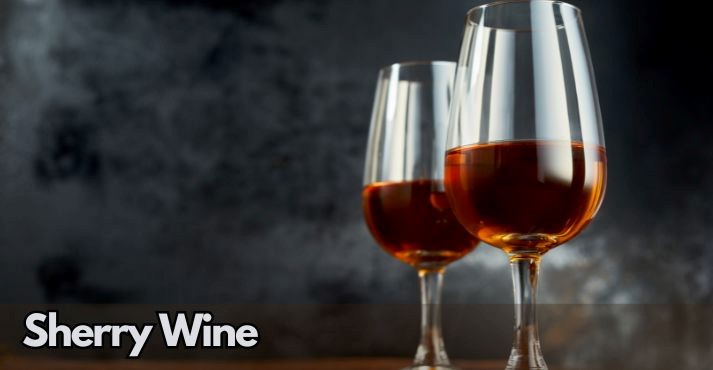
Sherry is a fortified wine from Spain’s Jerez region. It comes in various styles, from crisp and dry to rich and sweet. It’s a versatile choice for wine lovers, whether sipped alone or with food.
Origins
Sherry wine comes from the Jerez region in southern Spain, where winemakers have perfected the art of aging wine through a process known as the Solera system. This method mixes wines of various ages, creating a wine with unmatched depth and complexity.
Production Process & Unique Characteristics
Sherry is made from white grapes fortified with brandy to increase its alcohol content. A unique aging process, the Solera system, gives Sherry its distinctive flavor profile.
Depending on the style, Sherry can be dry or sweet. The Solera process imparts a rich, complex character.
Varieties or Types
- Fino: A light, dry style, often with a delicate, saline tang.
- Oloroso: Rich, nutty, and fuller-bodied, this variety is aged for longer.
- Amontillado: A balanced style that starts dry and becomes more complex as it ages.
- Pedro Ximénez: A sweet variety made from sun-dried grapes, offering deep flavors of dried fruit and molasses.
Taste Profile
Sherry ranges from the crisp and dry Fino to the rich and sweet Pedro Ximénez. Fino has light, fresh, and slightly salty flavors, while Oloroso is deep and nutty.
Amontillado provides a middle ground with its nutty, oxidative complexity, while Pedro Ximénez is decadent and sweet, with rich, fruity notes.
Food Pairings
Sherry is adaptable when it comes to wine pairing. Fino Sherry is perfect with seafood or tapas, while Oloroso pairs wonderfully with roasted meats and aged cheeses. Sweet Pedro Ximénez is ideal for desserts like chocolate tarts or fruit-based pastries, adding a luscious depth to these dishes.
3. Madeira
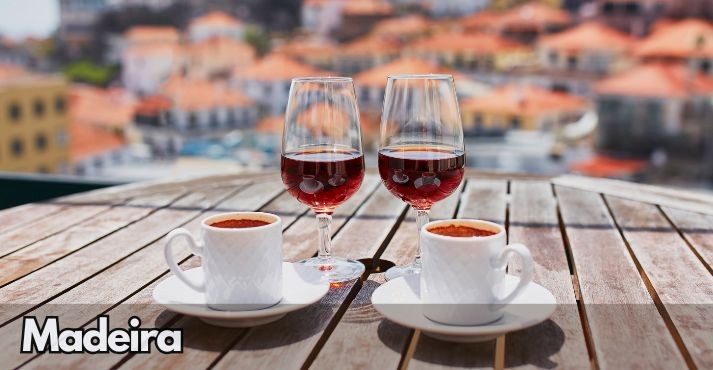
Madeira is a unique fortified wine from the island of Madeira. It is known for its extraordinary aging potential, which results from a distinctive heating process that provides remarkable flavors and allows the wine to age for decades.
Origins
Madeira wine comes from the volcanic Portuguese island of Madeira, off the coast of Africa. It has been produced since the 15th century and was historically favored for long voyages due to its strong character and ability to endure travel.
Production Process & Unique Characteristics
Madeira is fortified with brandy and treated with estufagem, a heating process that mimics the aging conditions of long sea voyages. This process gives the wine a distinctive caramelized flavor, and its resilience to aging allows it to develop complex flavors over time.
Varieties or Types
- Sercial: A dry style with crisp acidity and citrus flavors.
- Verdehlo: Slightly sweeter, with balanced acidity and a rounded mouthfeel.
- Bual: Rich, medium-sweet with flavors of nuts and dried fruits.
- Malmsey: The sweetest style, with honeyed flavors and rich, caramelized notes.
Taste Profile
Madeira’s flavor profile ranges from dry and citrusy (Sercial) to rich and nutty (Bual) and sweet with hints of honey and caramel (Malmsey). The wine’s acidity balances its complex, oxidative flavors, making it suitable for aging.
Food Pairings
Dry Madeira (Sercial) is excellent with seafood, while Bual and Malmsey pair well with desserts like toffee cake or rich chocolate. Thanks to their deep, complex flavors, these wines are also great with roasted meats and hard cheeses.
4. Vermouth
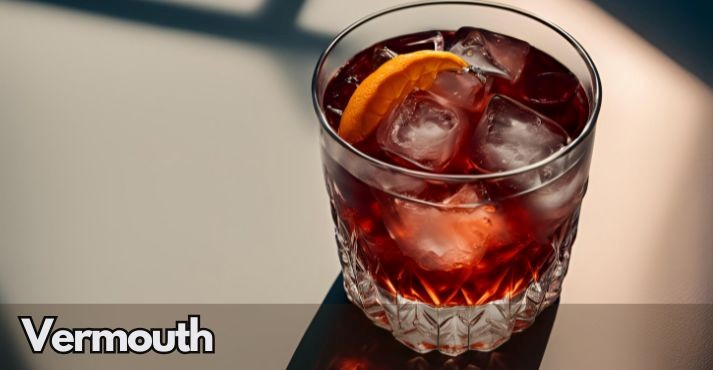
Vermouth is a fortified wine flavored with botanicals, such as herbs and spices. It’s widely known for its role in cocktails but is also delicious on its own, offering complex herbal and floral notes.
Origins
Vermouth’s origins are often debated, with Italy and France claiming to have invented it. Initially created for medicinal purposes, it became a popular drink that is essential for classic cocktails like the Martini and Negroni.
Production Process & Unique Characteristics
Vermouth infuses wine with various botanicals, including wormwood, cinnamon, and orange peel. After fortifying with brandy, the wine has a complex, aromatic flavor profile.
Vermouth is available in dry and sweet styles, with varying bitterness and herbal complexity.
Varieties or Types
- Dry Vermouth: Light, herbal, and dry, often used in martinis and other cocktails.
- Sweet Vermouth: Richer and sweeter, commonly used in whiskey-based cocktails like the Manhattan.
Taste Profile
Vermouth’s taste ranges from dry and herbaceous to sweet and aromatic. Dry Vermouth offers crisp, herbal notes, while sweet Vermouth is smoother and has spice, caramel, and orange peel flavors.
Food Pairings
Dry Vermouth pairs wonderfully with gin in a martini or light seafood dishes. Sweet Vermouth complements savory meals like roasted meats and is a great addition to cocktails like the Manhattan or Negroni.
5. Marsala
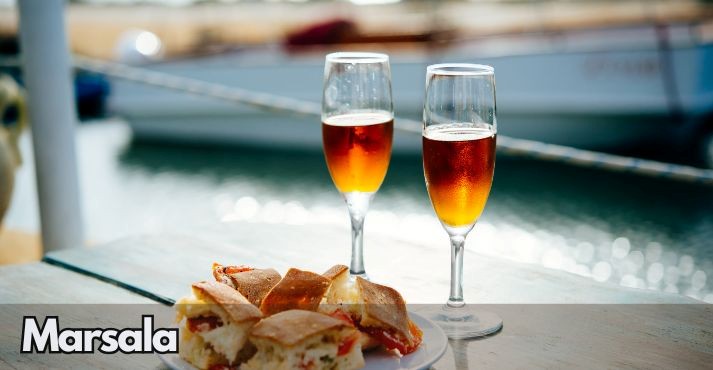
Marsala is a fortified wine from Sicily, Italy. It is renowned for its use in cooking and its ability to complement savory and sweet dishes. Its rich, nutty flavors add depth to food and drink.
Origins
Marsala is a fortified wine from Sicily, where it has been produced since the 18th century. The wine was initially marketed to the British, who sought a wine similar to Port, and it quickly gained popularity for its versatility in cooking and as a sipping wine.
Production Process & Unique Characteristics
Marsala is made by fortifying wine with brandy, which raises its alcohol content. It is aged in wooden barrels, developing complex, nutty, and caramelized flavors. Marsala is available in dry and sweet forms, offering distinct uses in the kitchen and at the table.
Varieties or Types
- Dry Marsala: Typically used in savory dishes such as sauces or stews.
- Sweet Marsala: Often served as a dessert wine or used in sweet dishes.
Taste Profile
Marsala offers rich, nutty flavors with notes of caramel, dried fruit, and oak. Dry Marsala is more savory and slightly bitter, while sweet Marsala is smooth, fruity, and honeyed.
Food Pairings
Dry Marsala pairs well with roasted meats and cheeses, while sweet Marsala is perfect with desserts like fruit tarts, tiramisu, or almond pastries.
6. Moscatel de Setúbal

Moscatel de Setúbal is a Portuguese fortified wine made from Muscat grapes. It is renowned for its vibrant floral and fruity notes. Perfect as a dessert wine or digestif, it’s often enjoyed with various sweets.
Origins
Moscatel de Setúbal is a wine from the Setúbal Peninsula in Portugal. The warm Mediterranean climate of the Setúbal Peninsula is perfect for viticulture, allowing Muscat grapes to flourish and reach their full potential.
This climate helps create the natural sweetness preserved through traditional fortification, where fermentation is halted by adding brandy.
Production Process & Unique Characteristics
The Muscat grapes used in Moscatel de Setúbal are typically harvested late in the season when they’ve reached their ideal sweetness. After fortification, the wine is aged for several years in wooden barrels, which helps develop its complex flavor profile, balancing sweetness with acidity.
Varieties or Types
While Moscatel de Setúbal is typically produced as a sweet wine, its intensity and aging process vary. Some bottles are richer and more concentrated due to extended barrel aging.
Taste Profile
This wine is known for its intense floral aromas, with notes of orange blossom, apricot, and honey. The flavor is sweet yet balanced by a refreshing acidity, making it smooth and vibrant on the palate.
Food Pairings
Moscatel de Setúbal pairs beautifully with fruit-based desserts, such as tarts or custards, and is a perfect match for strong cheeses like blue cheese. It also makes a delightful complement to foie gras or rich meats, offering a refreshing contrast to the bold flavors.
7. Liqueur Muscat
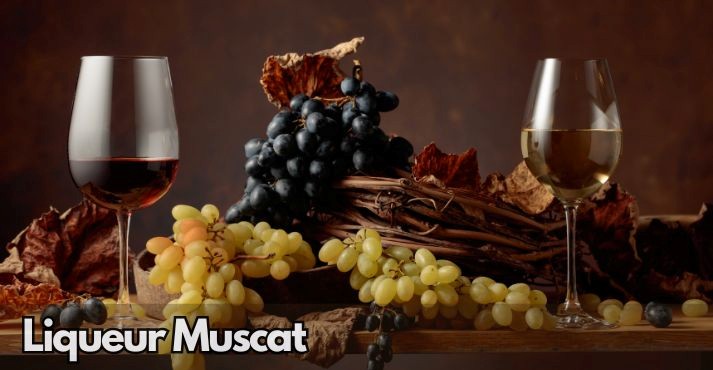
Liqueur Muscat, primarily produced in Australia, is a rich, syrupy fortified wine with deep flavors of dried fruits, caramel, and nuts. It’s perfect for those who appreciate a sweet, indulgent wine experience.
Origins
Liqueur Muscat is predominantly made in the Rutherglen region of Victoria, Australia. This region is known for its hot climate, which encourages the development of intense sweetness in Muscat grapes.
The wine is fortified with brandy, which halts fermentation and retains the grapes’ natural sugar levels.
Production Process & Unique Characteristics
The production of Liqueur Muscat involves a lengthy aging process, which allows the wine to develop layers of complexity. The fortification process ensures a high alcohol content, while the slow maturation in oak barrels imparts rich, toasty flavors and a velvety mouthfeel.
Varieties or Types
Liqueur Muscat typically comes in a single style, but variations in sweetness and aging can create different intensity levels. The wine is often categorized based on the length of aging, with older versions having deeper, more complex flavors.
Taste Profile
This fortified wine offers a luscious texture with prominent flavors of dried fruits, toffee, caramel, and nuts. It’s rich and smooth, with a syrupy consistency that lingers on the palate, making it an indulgent treat for wine enthusiasts.
Food Pairings
Liqueur Muscat pairs wonderfully with rich chocolate desserts, such as tarts and mousse, and can also complement strong, pungent cheeses like Roquefort or blue cheese. It’s perfect for those who enjoy a sweet wine to end a meal on a high note.
Potential Health Benefits
Fortified wines are known for their rich, complex flavors. When consumed in moderation, they may offer some potential health benefits.
While these wines should not be considered a cure-all, certain compounds in fortified wines have been linked to various health-related advantages. Below are some of the most frequently mentioned benefits:
Rich in Antioxidants
Fortified wines, especially those made from red grapes like Port and Madeira, contain antioxidants, particularly resveratrol. This compound, found in grape skins, is believed to help reduce the risk of heart disease by supporting cardiovascular health.
Resveratrol has been studied for its ability to protect blood vessels, reduce inflammation, and lower bad cholesterol levels (LDL).
A review published in Nutrients explored how resveratrol’s antioxidant properties improve endothelial function and potentially offer protection against cardiovascular diseases, such as atherosclerosis.
So, if you’re interested in fortified wine health benefits, moderate consumption of fortified red wines may offer significant cardiovascular advantages while enhancing their distinctive taste.
Digestive Aid
Fortified wines have historically been consumed as digestive aids, especially after meals. Sherry and Port, for example, are commonly served as digestifs, and are believed to help with digestion.
These wines are typically higher in alcohol content, which may stimulate the production of digestive enzymes, helping to break down food more efficiently.
Additionally, the richness of fortified wines is thought to help relax the stomach and alleviate any post-meal discomfort. Some studies have also linked moderate consumption of certain alcoholic beverages to improved digestion, as alcohol can increase gastric acid secretion, thus supporting the digestive process.
While enjoying fortified wines for their health benefits can be tempting, it’s important to consume them in moderation to avoid any potential adverse effects from excessive alcohol consumption.
Conclusion
Fortified wines are a result of centuries of craftsmanship, offering a range of bold and distinct flavors. Each variety, from Port to Vermouth, reflects its unique origins and production methods.
The addition of spirits during fermentation boosts both alcohol content and complexity, creating rich flavors that stand out from regular wines. In addition to their taste, fortified wines may provide health benefits, such as antioxidants and digestive support, when consumed in moderation.
However, when exploring fortified wines, it’s also essential to read a wine label carefully to understand more about the wine’s alcohol content, production method, and style.
So, whether incorporated into cooking, crafting cocktails, or enjoying them on their own, the uses of fortified wines are as diverse as the wines themselves, making them a great addition to any kitchen or bar.





























